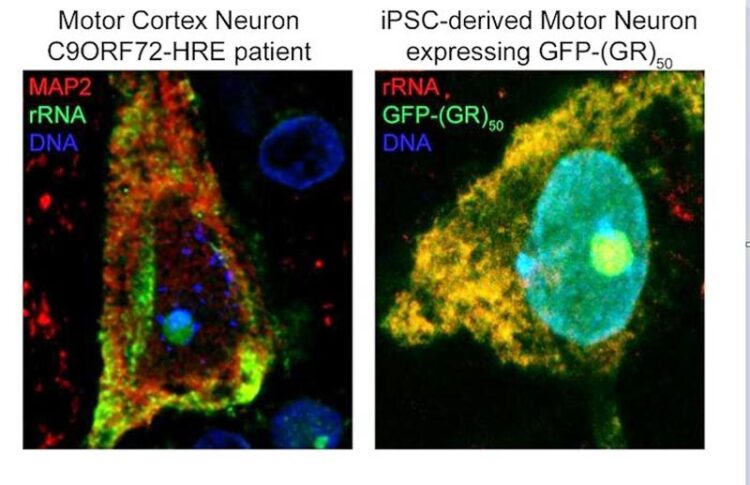A toxic union for neurons

Study led by the UB with patient samples and in vitro and in vivo models designs a molecular trap to fight this disease.
Credit: Northwestern University (United States)
New therapeutic strategy to reduce neuronal death in amyotrophic lateral sclerosis.
Amyotrophic lateral sclerosis (ALS) is a neurodegenerative disease that affects neurons in the brain and spinal cord causing loss of muscle control. A study by the University of Barcelona has designed a potential therapeutic strategy to tackle this pathology that has no treatment to date. It is a molecular trap that prevents one of the most common genetic ALS-causing peptide compounds, the Poly-GR dipeptide, from causing its toxic effects in the body. The results show that this strategy reduces the death of neurons in patients and in an animal model (vinegar flies) of the disease.
The first authors of this international research study published in the journal Science Advances are the experts Juan Alberto Ortega Cano, from the Faculty of Medicine and Health Sciences and the UB Institute of Neurosciences (UBneuro), and Ivan Sasselli, from the Materials Physics Centre (CSIC-UPV/EHU). Researchers from the University of Zaragoza and Northwestern University (United States) have also participated in the study.
One of the most frequent causes of ALS is the mutation in the C9orf72 gene, found in approximately 33% of patients affected by familial ALS (FALS) and 5% of those affected by sporadic ALS in Spain. In these patients, dipeptides with a large number of positive charges are generated and they provoke highly toxic effects on motor neurons. In the first part of the study, the researchers combined computational and experimental techniques to improve the molecular understanding of these dipeptides and how they produce this pathological process.
A toxic union for neurons
The results showed that the toxicity of these compounds is partly due to those that bind to ribosomal RNA (rRNA), a molecule involved in the process of translation of genetic information and protein synthesis in the cell. “We have observed that these dipeptides, specially those rich in the amino acid arginine (poly-glycine-arginine or Poly-GR), bind to a specific region of rRNA, affecting the biosynthesis of ribosomes (small structures responsible for synthesising proteins in our body) and protein translation in human motor neurons, leading to their death”, says Professor Juan Alberto Ortega Cano. “Moreover — the researcher adds — this interaction between Poly-GR and the rRNA is stronger than the interaction between the Poly-GR with other ribosomal proteins that had been previously described in other studies, and it tells us why these dipeptides have a high affinity for binding to ribosomes in cells”.
Given these results, the researchers designed an innovative strategy to trick the Poly-GR dipeptides and reduce their toxicity. They created a trap, a molecule that mimicked the specific rRNA sequence to which Poly-GR dipeptides bin during the pathological process, in order to avoid the neurotoxic effects of this binding.
The application of this strategy in neurons derived from in vitro patient tissue and in in vivo models of the disease (vinegar flies) shows that “it reduces the defects in ribosome biosynthesis in protein translation and toxicity in cells expressing Poly-GR, as well as death in motor neurons of ALS patients with mutations in the C9orf72 gene”, notes the researcher.
Although much research remains to be done to validate and fully understand how this strategy works, the researchers note that these promising results reinforce the idea that the use of RNA traps is useful “not only to study RNA-protein interactions, but also to protect neurons from the detrimental effects of abnormal proteins generated in other neurodegenerative diseases”.
Journal: Science Advances
DOI: 10.1126/sciadv.adf7997
Method of Research: Experimental study
Subject of Research: Animals
Article Title: CLIP-Seq analysis enables the design of protective ribosomal RNA bait oligonucleotides against C9ORF72 ALS/FTD poly-GR pathophysiology
Article Publication Date: 10-Nov-2023
Media Contact
Rosa Martínez
University of Barcelona
rosamartinez@ub.edu
Office: 34-934-035-544
Original Source
All latest news from the category: Health and Medicine
This subject area encompasses research and studies in the field of human medicine.
Among the wide-ranging list of topics covered here are anesthesiology, anatomy, surgery, human genetics, hygiene and environmental medicine, internal medicine, neurology, pharmacology, physiology, urology and dental medicine.
Newest articles
Faster, more energy-efficient way to manufacture an industrially important chemical
Zirconium combined with silicon nitride enhances the conversion of propane — present in natural gas — needed to create in-demand plastic, polypropylene. Polypropylene is a common type of plastic found…

Energy planning in Ghana as a role model for the world
Improving the resilience of energy systems in the Global South. What criteria should we use to better plan for resilient energy systems? How do socio-economic, technical and climate change related…

Artificial blood vessels could improve heart bypass outcomes
Artificial blood vessels could improve heart bypass outcomes. 3D-printed blood vessels, which closely mimic the properties of human veins, could transform the treatment of cardiovascular diseases. Strong, flexible, gel-like tubes…





















